Bob Mayer's Blog, page 40
May 19, 2020
Day 69: 2020 Pandemic. Water Sources in Nature, Part IV
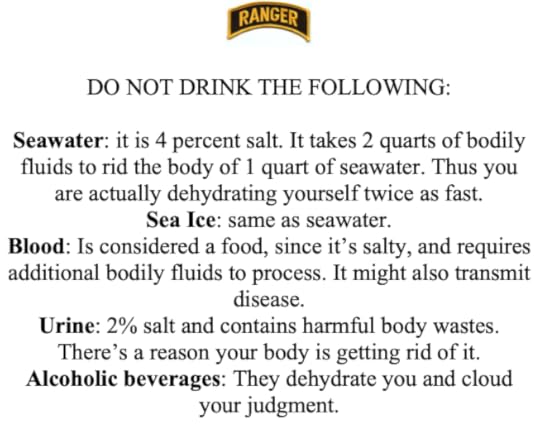
Warning! Purify any water that you are not positive is drinkable.
Rainwater collected in clean containers is usually safe for drinking. This is the quickest and most effective way to gather potable water.
Lakes, ponds, swamps, springs, streams. Must be purified regardless of how clear and clean it looks. This is especially true if it is anywhere near human settlements.
Underground water: Muddy ground indicates a water supply. You can filter the muddy water or dig down about a foot and gather what collects. It still must be purified.
Snow and ice: Are as pure as the water from which they came, this is particularly true for ice. Do not eat snow or ice without melting first, as doing so will reduce your core body temperature and actually lead to dehydration more than hydration. If you carry a water container in freezing temperatures, remember that it will freeze. Keep your ready source of water inside your coat so remains liquid.
Green bamboo thickets are a source of fresh water. Water from green bamboo is clear and odorless. To get the water, bend a green bamboo stalk, tie it down, and cut off the top. The water will drip freely during the night and collect. Old, cracked bamboo may contain water. Bamboo is a lot more common than you realize. When you did your Area Study, this is something you should have looked for: all the sources of water that you might not have considered before.
Morning dew can provide water. Use an absorbent cloth (this is one case where cotton isn’t rotten) or a handful of long grass and wick up moisture that has condensed. You can also tie rags or tufts of fine grass around your ankles and walk through dew-covered grass before sunrise. As the cloth, rags or grass tufts absorb the dew, wring the water into a container. Repeat the process until you have a supply of water or until the dew is gone. This water is considered potable (unless you collect it off of poison ivy or recently fertilized/sprayed grass, etc.)
Banana/plantain trees: Cut down the tree, leaving a stump about a foot high. Scoop out the center, leaving a bowl shaped hollow. Water from the roots will come and being to fill the hollow. The first several fillings will be bitter, but then it was become more palatable. This can supply water for up to four days. If you are going to re-use, cover it to keep insects and bugs out.
Tropical vines: Cut a notch as high as you can reach. Do not drink if it is sticky, milky or bitter-tasting.
Coconuts: The milk from unripe (green) coconuts. The milk from mature coconuts contains a laxative.
Using animals to locate water:
Since we’re mammals, using other mammals is common sense. Most mammals in nature will seek out water at dawn or dusk. Following game trails can lead you to water.
Melting ice and snow: Both are water in different forms. If you have a choice, melt ice as it produces greater volume than snow. If you are melting snow, keep adding and pressing the snow down or else you will get a cavity at the bottom of your pan or can. Sea ice is the same as sea water and not drinkable.
The Green Beret Pocket-Sized Survival Guide (same as above, minus the preparation part in order to be smaller in print)
The Green Beret Preparation and Survival Guide. Also in Kindle Unlimited.
Hey– my first 9 Area 51 books are only .99 this month. If you’re interested in seeing the entire history of mankind rewritten, check them out. Now what happened– but WHY things happened.
May 18, 2020
Day 68: 2020 Pandemic. Water for Survival, Part III

The spread of Giardia has made most water sources that you used to be able to trust, unsafe. Whatever purification system you use, make sure it will get rid of Giardia. Giardia is spread through animal dropping. If you get this bug, it will seriously degrade you physically and reduce your ability to survive.
By drinking non-potable water you may contract diseases or swallow organisms that can harm you. Examples of such diseases or organisms are—
Dysentery. Severe, prolonged diarrhea with bloody stools, fever, and weakness.
Cholera and typhoid. You may be susceptible to these diseases regardless of inoculations.
Flukes. Stagnant, polluted water—especially in tropical areas—often contains blood flukes. If you swallow flukes, they will bore into the bloodstream, live as parasites, and cause disease.
We have the problem of industrial and chemical pollution almost everywhere. We have little idea what run off is going into the water. Stay away from water that is near roads.
Just today the EPA put out that they want to relax even more restrictions on poisons that can be allowed to run off into our water. Profit over people’s health.
Don’t drink downstream of factories that discharge into the water, sewage plants that discharge, mines or, frankly sites of major human habitation.
Don’t drink water draining out of utilized farmland.
If you are in an area that has been flooded (aka Katrina), consider all water sources affected by the flooding to be contaminated, even if they were previously considered drinkable.
You have to assume that any water that isn’t marked as potable (drinkable) is contaminated. Even in the deepest forest, there is a chance the water is tainted. Always stay on the safe side, because contracting giardia is no fun at all and cholera can be fatal.
There are items in your house that can be used to purify water:
Chlorine Bleach. Standard bleach is 5% chlorine. If the strength is not known go with ten drops per quart or liter for clear water, double that for murky water.
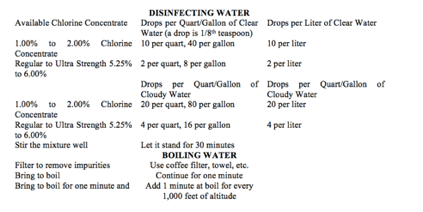
FREE TODAY: The Green Beret Pocket-Sized Survival Guide (same as above, minus the preparation part in order to be smaller in print)
The Green Beret Preparation and Survival Guide. Also in Kindle Unlimited.
May 16, 2020
Day 66: 2020 Pandemic. Do You Feel Very, Very Strange? Out Of Touch With Reality? You’re Not Alone

We are undergoing a psychological condition called ‘derealization’. It’s a dissociative disorder which involves disruptions or breakdowns of memory, consciousness, awareness, identity, and/or perception. It’s reported that half of all adults have a derealization episode in their life, but only 2% suffer from it to an extent they are diagnosed with it and need treatment.
Right now, almost all of us are going through an episode of it. If we’re aware of reality, that is. You’d almost be more crazy not to be experiencing it.
Are you experiencing the following?
Detached from your environment.
Distorted perception of time, space, and size of things around you.
Feeling of unreality from the world around you, as if in a dream or trance.
Feeling as if everything is foggy, fuzzy, or warped.
Sense of being disconnected from those around you as if you’re trapped in a bubble.
Thoughts of going crazy or being very ill.
Yeah. Thought so. Who are you, anyway? Are you really there?
Even Cool Gus is looking a little dazed and confused.

I’ve been thinking about how extroverts and introverts are handling lockdown. The obvious is that it’s hard on extroverts (75% of the population) because they’re isolated. But it’s also hard on introverts because they tend to absorb the vibes of the world around them more than extroverts. Not only are introverts having their own sense is unreality, they’re picking it up from others.
The primary treatment for derealization is therapy. Secondary treatment, according to Cool Gus, is scratching a dog’s belly and giving them treats. If there is no dog, cats are not a substitute; (according to Cool Gus, don’t blame me).
The biggest thing to realize is that you’re not alone and you’re not crazy. Frankly, right now, the world is pretty crazy!
FREE TODAY: The Green Beret Pocket-Sized Survival Guide (same as above, minus the preparation part in order to be smaller in print)
The Green Beret Preparation and Survival Guide. Also in Kindle Unlimited.
May 15, 2020
Day 65: 2020 Pandemic. Survival Guide is Free on Kindle; Getting Back To Water
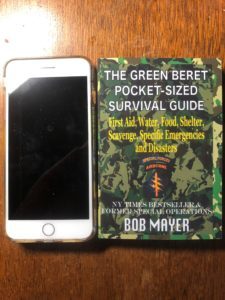
And, technically, it is pocket-sized if you put it on your phone in the Kindle ap. But the print size is shown above against an iPhone8, which is just slightly bigger than an SE version. The Green Beret Pocket-Sized Survival Guide.
More info on water:
In your home, you can add another half-gallon of water per person above the minimums from Day 63 recommended– for things such as cleaning, brushing teeth, etc. This isn’t essential, but useful for mild situations. Do not use drinking water for these reasons if you’re in a moderate or extreme emergency.
Your water in your house is ultimately dependent on electricity. While you may have had running water during the last local blackout, a major blackout will shut down the water processing and pumping stations. If you have a well, the pump runs off electricity. Can you get water out of your well without power?
Do you have pets? Add in water for them, but in moderate or extreme emergencies, let them forage for water. They can do it much better than you.
Quite a bit of the food you have stored will require water to prepare. That’s why you might think the recommended gallon a day seems high.
We have water already stored in houses in places we might not automatically think of:
Our hot water heater contains a considerable amount. There is a drain at the bottom. Make sure you have something to collect the water in, open the drain, then open a faucet to complete the water circuit. (Make sure, if not already off, that you turn off the gas/power to the heater before working on it. If the power/gas is already off and comes on, make sure you immediately refill the heater before turning it back on or else it can overheat.)
The water pipes in your house can be drained of the water in them.
Our toilet tank (not the toilet bowl) contains fresh water. Get over it and use it.
A swimming pool or hot tub contains non-potable water which you can make potable. These techniques are covered in Survival—in the book that’s free today!
If you have adequate warning, you should fill every available container with potable water. Also fill all tubs and sinks.
Tomorrow, more on water, including checklists and emergency sources.
The Green Beret Preparation and Survival Guide. Also now in Kindle Unlimited.
The Green Beret Pocket-Sized Survival Guide (same as above, minus the preparation part in order to be smaller in print)
May 14, 2020
Day 64: 2020 Pandemic. People Simply Aren’t Taking This Seriously
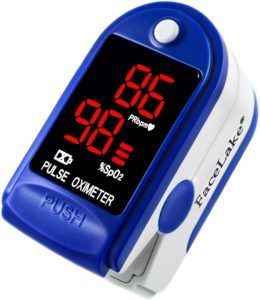
I’ll get back to more information on water tomorrow, but today I’m in a state of shock over the images from Wisconsin, where their supreme court overturned the governor’s lockdown and people celebrated by crowding into bars.
Seriously. There’s photos.
In Texas, there are armed people standing outside barbershops so people can get haircuts, because, you know, tough guys need haircuts.
It’s so weird that those who threw “snowflake” around so casually now seem to be the ones who can’t tolerate some inconveniences in their lives. Yes, a job is important. But getting a haircut? Going to a bar?
For many, they think this is a problem they won’t have to face. It’s an old people problem. Or a city problem. Here in TN we’ve had huge outbreaks in prisons and in the towns outside the prisons, because the guards do have homes.
This graph below is what happened during the last major pandemic. We’re opening up for a world of hurt.

Here is an article from the NY Times from someone who is recovering from COVID-19. I recommend reading it.
In an earlier post I mentioned getting an oximeter. As she says: you get below 95, you might have a big problem. A lot of the deaths are happening because people think they can stay home and beat this—more realistically they’re afraid of the cost of getting medical help. By the time they do, it’s too late.
Tomorrow, more on water, including checklists and emergency sources.
The Green Beret Preparation and Survival Guide. Also now in Kindle Unlimited.
The Green Beret Pocket-Sized Survival Guide (same as above, minus the preparation part in order to be smaller in print)
May 13, 2020
Day 63: 2020 Pandemic. Water is Life’s Essential

While water does not appear to be priority for most people in terms of the pandemic, it is a priority for survival if some other disaster layers in on top.
While many people focus on the power going out, of more essence to survival is the loss of potable water. Your water depends on a source, power and pipes, all of which can be disrupted by a wide array of emergencies. How much drinkable water do you have on hand without relying on the tap?
Another huge factor for water availability is when your normal water source gets contaminated. This is becoming more and more common. Flint, Michigan is an example of long-term contamination. One of the by-products of floods is that the water supply quickly gets polluted as contaminants in the ground and in various storage facilities are mixed together with the flooding waters. Eighty percent of natural disasters are accompanied by flood. If you watch disaster relief, the first thing that is brought in is potable water.
The first step in water is at least two cases of water per person in your household. Just buy them, toss them in a dark space, and forget about them. Until you need them.
I recommend getting a water filter. For starters, something like the Katadyn Filter is a good buy. It’s the one I have in the house as an emergency backup.

We always put a high-end water filter in any house we live in, preferably whole house, but at least for the sink which is where get our drinking water and store in metal drinking containers. A portable filter is great for emergencies.
Separate from the normal sources of water in civilization, do you know how to acquire safe, drinkable, water? Do you have a source of water within reasonable distance of where you live? Is the water drinkable? Can you make it drinkable? You have to assume that any water that is not marked as potable (drinkable) is contaminated. Even in the deepest forest, there is a chance the water is tainted. Always stay on the safe side, because contracting giardia is no fun at all and cholera can be fatal.
On average, we can survive three days without water versus three weeks without food.
Over three-quarters of your body is composed of fluid. Perspiration is not the only way you lose water. We actually lose more water just by breathing. And you can’t stop that loss. We lose around 2 to 4 cups of water a day by exhaling (16 cups equal one gallon). We lose about 2 cups via perspiration. We lose ½ to a cup just from the soles of our feet. We lose six cups via urination. When you add that up (and it wasn’t easy converting all that) you lose more than half a gallon of water a day just existing; more depending on the weather and your activity level.
In your home, you need to be prepared for at least 3 days for mild emergencies, but I recommend doubling that. Your average water bottle is 500 milliliter. Here’s the math to make it easy: 7.5 bottles equal a gallon. Your average case of water has 24 bottles, so let’s round up to three gallons. That will last a person 3 days. A case of water per person in the household will last three days. If you are in a very hot environment, definitely double that.
Regardless, I recommend storing at the very least two cases of water per person in the household. The FDA considers bottled water to have no expiration date as long as the lid is sealed. Expiration dates printed on bottles are voluntary and reflect concern over taste and color; not safety.
Depending on the possibilities of emergencies in your area, more is better. FEMA recommends having at least a two-week supply for moderate emergencies. I recommend a month at a gallon per person, per day for extreme emergencies.
Tomorrow, more on water, including checklists and emergency sources.
If you’re following these posts, you are slowly getting prepared, step by step, similar to what I’ve laid out in the book below.
The Green Beret Preparation and Survival Guide. Also now in Kindle Unlimited.
The Green Beret Pocket-Sized Survival Guide (same as above, minus the preparation part in order to be smaller in print)
May 12, 2020
Day 62: 2020 Pandemic. Get A Basic Grab-n-Go Bag Ready
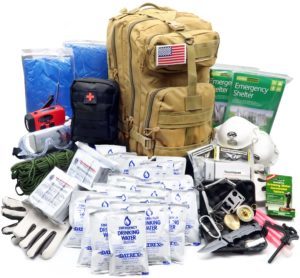
Beyond the Four Basics and doing an Area Study, the next priority is having a Grab-N-Go bag. At least one. I have one in the house, one in the Jeep, one at my ERT, Emergency Rally Point, yada yada and with the bisque.
There’s nothing wrong with buying a pre-packaged kit if you don’t have the time to do an Area Study and then selectively pack one. I bought this for my son in San Diego since it included many of the essentials:
Unfortunately, it’s currently unavailable on Amazon, but that doesn’t mean you can’t backorder it. Below is something that is available now and actually has more, although it doesn’t come in a backpack, but a bag you can carry by the handles or roll. Or put in a shopping cart and push down the road, aka The Road.
Complete Earthquake Bag – Emergency kit for Earthquakes, Hurricanes, Wildfires, Floods + other disasters (3 person, 3 days)
However, there is much more than just the kit. Clothes, perhaps a vest and more can make a big difference.
The list below is just a sample of what I discuss in the book, The Green Beret Preparation and Survival Guide. I also link to the items on Amazon in the book.
You should adjust based on your environment and your Area Study. More importantly, how much will fit and you can carry on foot? Factor in what gear you can readily scavenge or make from field expediency.
The gear is broken down by areas. Feel free to personalize, upgrade, whatever. This is a guideline. The free slideshow linked has links directly to specific geat at Amazon.
The bag itself. This goes back to how much you can carry. Remember, the bigger the bag, the more obvious it is. And the more someone might want to steal it from you. If you have no experience with backpacks, go to your local sporting good store (REI always has knowledgeable personnel working) and ask. I just noticed REI is starting to open their stores, although most are going for curbside pickup.
Do you want just a regular backpack like kids take to school? An internal frame ruck? External frame? Built in hydrating system? The choices are limitless. What you should do is go down this list first, write out what you’d like in the bag, get the stuff, then find a bag that fits the stuff. You might find you’re trying to carry too much. That’s when you take out the items depending on importance. Also, consider the color of the bag. I’d go with, if not camouflage, something that is dark in color, or that matches your surrounding terrain.
WATER: 6 full 500ml water bottles or 24 125ml pack of emergency water. This is your immediate emergency supply if you have no time to fill up your . . .
Water Containers. Either a built in water supply such as a Camelbak or pockets/clips for water carriers. Most packs have external loops on which you can secure canteens and water carriers. Remember, though, that water sloshing about and things on the outside of your bag banging about, violates noise discipline. Your first priority is to fill up this container with potable water or fill from your household water stash if bugging out. The water bottles are to sustain you to get to that point. They also then become extra water containers.
Water Purification. Lifestraw equivalent and two bottles purification tablets. Water Filter; Waterproof Sacks, inner bags, Ziploc bags. Everything inside your backpack that can get wet needs to be inside a waterproof sack/inner bag. Have a supply of assorted size Ziploc bags for smaller gear. Empty compressible water containers: For after establishing base camp
FIRE: Windproof lighters. 3 each; Windproof matches with striker; Magnesium fire starter. Make sure you practice with it before trying it for the first time in the midst of a downpour and hurricane force winds; Portable stove and fuel supply. You need a small stove with a fuel supply for at least a week. Go with the stove for cooking initially instead of a fire because of smoke and light discipline.
FOOD: Minimum 6 days supply. Add in power bars, etc. Survival meals; Pot to cook in, utensils, pot holder.
FIRST AID: Emergency first aid kit; Medical mask; Quikclot sponge. 2 each; Universal Splint, rolled. 1 each; Extra medication (minimum one week’s worth); Extra glasses
SHELTER: Emergency, light weight sleeping bag. These are also called bivy sacks. They are a step up from the emergency blankets you see advertised and more effective.
Small tent or poncho. This depends on multiple factors: how many people, portability, weather, etc. As you’ll see later, my recommendation for the hide site is to make it in a remote location. If you’re hard-core, you eschew the tent in favor of a field expedient shelter that can be put up and taken down quickly, using a poncho and paracord. This also depends on the weather/Area Study.
Sleeping pad. Either a fixed pad or Thermarest self-inflating. Not just for comfort, but in cold environments, staying off the ground, saves you heat. In a hot, jungle environment, this can be swapped out for a hammock.
Sleeping bag*. Your decision on a sleeping bag depends on your Area Study. Plus 20? Minus 20? A bivy sack is useful for both shelter and sleeping. You need something waterproof to insert the sleeping bag into.
TOOLS: Leatherman, Mutli-Tool (in addition, consider adding Leatherman, Crunch Multi-Tool)
Portable, hand crank, emergency radio, rechargeable flashlight.
Battery powered headlamp. Often, in the dark, doing survival activities, you’ll need both hands, so this helps. Also, consider having a red lens cover or red option for the light so you can use it at night and not emit a large signature.
Fixed blade survival knife. We used to argue about knives all the time in our team room. Which type was best, where to carry it, etc. etc. I like a six to eight inch blade. With sharpening stone.
Folding saw. These are very useful in cutting firewood, clearing paths and construction.
Paracord/550 cord. 100 feet at least. Parachute cord or 550 cord as we called it in the army. This is very strong, very light and narrow cord that again, will have more uses than you can imagine.
Signal mirror; Signal panel, such as a VS-17. This is why everything else is muted or camouflaged. You keep this packed away until you actually want to signal someone.
Fishing Line, hooks, sinkers and some lures. These come in handy kits.
Snare wire. Indispensable. You’ll be amazed how many different uses you’ll find for this beyond setting snares. Traps are a much more efficient way to catch game over hunting. Hunting with a gun also leaves a noise signature that might attract unwanted guests.
Electrical tape. 1 roll; Duct tape. 1 roll.
Candles. Primarily in a winter environment for light, warmth, fire, glazing snow cave, etc.
Survival axe; Machete. If applicable to your environment and zombie threat level; Snow shovel. If applicable to your environment; Pocket chainsaw. Light weight, small, but can be very useful in a variety of situations. Such as amputating your own arm if its pinned to a canyon wall by a boulder. Joking. Not.
MISC: Compass. Zip ties. An assortment. Very useful. Map of the area. A physical, geographic map. 1:24,000 scale at least. Waterproof Map case. Make sure there is a way to tie this off to you. Pen, pencil and paper. Identification. Driver’s license, passport.
Cash. ATMs won’t work if the power is out. Cash will be an initial barter material until it gets real bad when food, first aid, expertise (especially medical) and weapons/ammunition will take priority.
PERSONAL ITEMS: Toilet paper. Baby wipes are preferable. Toothbrush with paste. Razor and blades. Camping soap. Camping towel (small, dries fast). Feminine hygiene products as needed.
CLOTHING: Pair of workout shoes or broken in boots, in case you have to bug out and don’t have time to put on your proper bug out clothing. Extra socks. At least three pair. Boot bands. Seems trivial, until things start crawling up your legs. Wool watch cap. Most heat escapes through the head and/or: Boonie hat. Protection from the sun, absorbs sweat. Gloves. For weather as appropriate but also for working. Something that gives you a good grip while also protecting your skin. When I was in the field, I wore thin gloves pretty much all the time. They allowed me to handle my weapon but also protected my hands.
All these checklists and links are HERE.
The Green Beret Preparation and Survival Guide. Also now in Kindle Unlimited.
The Green Beret Pocket-Sized Survival Guide (same as above, minus the preparation part in order to be smaller in print)
May 11, 2020
Day 61: 2020 Pandemic. How Bad Can It Get?
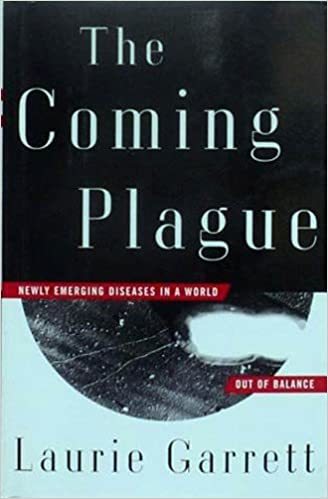
Official reports show that 33,000,000 Americans have filed for unemployment in the past month. The equivalent of the work force for half the states in the Union. Remember, that’s just the people who’ve filed. It doesn’t count those who haven’t yet filed or, more importantly in our gig economy, those who still have some sort of job but have seen their income drastically reduced either by less hours or fewer sales for the self-employed. I’m giving away more free books than ever, but selling less. But I have a job for which I am thankful.
There are lines for foodbanks in Geneva, Switzerland. We’ve seen the photos of miles long lines of cars at foodbanks here in the States. Meat-packing plants are closing because they’ve become hot spots.
Those in power want to normalize thousands of deaths a day. They compare it to car crashes, which is ludicrous. They say it’s only the old, which isn’t true. They are painting this as a binary choice: open or closed. When the smart path, is a slow, phased re-opening. But they’ve thrown out the re-opening playbook done by experts.
Yes, the economy is in the tank. Re-opening abruptly isn’t going to “re-start” it. Many jobs and businesses are gone forever. Many others will take years to recover. Because I’m a writer, my brain meanders. I often start pulling on a job thread. Driving past the Knoxville Airport the other day I saw planes parked and lined up, out of service. Nothing like that since 9-11. Yet we’re having a daily 9-11. So the flight crew is what? Furloughed? The people who work the ground? Cut back? The shops in the airport? Probably closed. The companies that supply those shops? Cut back, such as the bookstore no longer racking titles. The airport hotel that housed flight crews and travelers? Cut back. All the shops along the road the airport is on? And on and on the ripple touches everyone.
Laurie Garrett is a Pulitzer Prize winning author who penned a book: The Coming Plague. In 1994. She was recently interviewed in several magazines and in the NY Times. She predicts we will have three years of turmoil and I humbly agree with her. I was rather stunned today while driving to see day cares open; to see restaurants open and people inside. I still am dumbfounded every day to see cars lined up at Chik-Fil-A and Starbucks. Seriously?
I’m not one of those half-full/half-empty people. I’m a “what’s in the damn glass” person.
And what’s in it is COVID-19. If people not being able to go to the beach or their favorite restaurant causes civil disobedience and unrest, what will not be being able to feed their kids cause? That’s how bad it can get. Ponder that. Process it. Re-opening is not going to fix it, nor is the long off November election. We are in a broken system that is being attacked relentlessly. It is up to us to save ourselves.
The first step is to accept reality. It’s bad and will get worse. I wish it won’t, but my wishes don’t change things. Neither do yours. So I will reboot this blog and we’ll get started preparing. The good news is we’re through the initial surge where preparation seemed foolish. It’s more urgent than ever. And we will do it.
The Green Beret Preparation and Survival Guide. Also now in Kindle Unlimited.
The Green Beret Pocket-Sized Survival Guide (same as above, minus the preparation part in order to be smaller in print)
FWIW: Lost Girls is free today, 11 May through 13 May. The first nine books of my Area 51 series, where I rewrite the entire history of mankind are .99 each through all of May. HERE
May 9, 2020
Day 59: 2020 Pandemic. The Biggest Mistake We’ve Made So Far

We wasted the last two months. That’s what historians will focus on. Why did we shut things down and not aggressively test? What good did it do us other than bring record unemployment and no clue how widespread the virus is and who has it?
What’s happening now is the country is piecemeal re-opening and we will experience new hot spots, because we don’t know who has it and who doesn’t, and then the second closing will be crushing and will take at least a decade, if not a generation, to recover from.
While we have numbingly accepted our president lies more than he speaks the truth, the biggest daily lie he’s telling (and believes) is that our testing the best in the world. It’s not. The term “per capita” just doesn’t resonate with him.
It’s not easy to get data on testing, which is weird, since it’s the single most important number we should be focused on right now in addition to deaths. The CDC site makes little sense. The data at the top comes from this web site: www.covidtracking.com
Our population is 328.2 million. We haven’t even tested 10 million; and the disease tends to be very asymptomatic. Which means we’ve tested barely 3% of our population. Even South Korea, which aggressively tested a much larger percentage is having to backtrack on its re-opening. We’re going to get slammed.
I’m sure people will scream “fake news”. Whatever. Please, then, direct me to a better site? DOD is hiding its data because of operational reasons. We now know some states are fudging their data to look better. Bottom line is we don’t have the data because we don’t have the testing, both because we have a leader who doesn’t want to know bad news. If you’re read Art of the Deal and been conscious the last couple of decades, you know Trump very much believes his reality is reality, regardless of how many people die.
Bottom line: we’ve blown it. We’ve wasted all the time since the first urgent alerts about this pandemic were sounds and the federal government is still sitting on its ass as regards testing.
The irony is that the president’s reality is changing in front of our eyes as it appears the White House despite all its testing, is now a hot spot.
I know we’re worn out and numb, but unless we turn things around soon, it’s going to be much, much worse. The signs are all there. Not only the virus, but the dismantling of the Republic via DOJ’s recent actions, the Supreme Court facing critical cases as to whether the Executive Branch is exempt from Congressional oversight. If things continue the way they are going, the United States will be done before the election. And there won’t be one.
What can we do? I’m going to shift the focus of this blog down to a more basic level: since the worst case is bubbling up around us, we must prepare for the worst case.
I hope I’m wrong.
The Green Beret Preparation and Survival Guide. Also now in Kindle Unlimited.
The Green Beret Pocket-Sized Survival Guide (same as above, minus the preparation part in order to be smaller in print)
May 8, 2020
Day 58: 2020 Pandemic. 75th Anniversary of VE Day

It was a good day, even while many, including my father, were still fighting in the Pacific Theater.
Many historians have traced the origins of World War II. Most point to the awful peace treaty after the end of the First World War, which was the Great War, until there was a second one, and then it became #1. The point is, the world has always been in turmoil because we are irrational creatures. The concept of using violence to solve disagreements is, inherently, insane. It does not prove who is right necessarily, but VE Day clearly had the right side win.
As we wade through the beginning of our darkness, let us remember those who fought that great fight and prevailed.
And let us commit ourselves to the great fight ahead so we can prevail.
The Green Beret Preparation and Survival Guide. Also now in Kindle Unlimited.
The Green Beret Pocket-Sized Survival Guide (same as above, minus the preparation part in order to be smaller in print)



